|
FAQs about Fahaka, Fajaka, Nile Puffers,
Tetraodon lineatus
Related Articles: The Nice Puffer: Colomesus asellus , the
South American Puffer by Neale Monks, Freshwater Puffers, Alone But
Not Lonely: The Importance of Keeping Puffers
Individually by Damien Wagaman, Puffers in General, True Puffers, Brackish Puffers,
Burrfishes/Porcupinefishes,
Tobies/Sharpnose Puffers, Boxfishes, Puffy & Mr.
Nasty, (Big) Pufferfish Dentistry By Kelly Jedlicki and Anthony Calfo
Small Puffer
Dentistry By Jeni Tyrell (aka Pufferpunk), Puffer Care and Information by John
(Magnus) Champlin, Things That My
Puffers Have Told Me by Justin Petrey,
Related FAQs: FW Puffers
1, FW Puffers 2, FW Puffer Identification, FW Puffer Behavior, FW Puffer Selection, FW Puffer Compatibility, FW Puffer Systems, FW Puffer Feeding, FW Puffer Disease, FW Puffer Reproduction, BR Puffer
Identification, BR Puffer
Selection, BR Puffer
Compatibility, BR Puffer
Systems, BR Puffer
Feeding, BR Puffer
Disease, BR
Puffer Disease 2, BR Puffer
Reproduction, Puffers in
General, True Puffers,
|
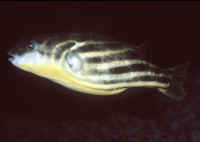
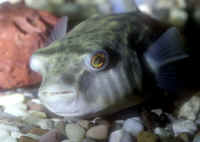 |
|
Tetraodon lineatus Linnaeus
1758, the Fahaka, Lined Freshwater Puffer. Africa: Nile,
Chad basin, Niger, Volta, Gambia, Geba and
Sngal Rivers. Freshwater, brackish; pH
range: 7.0; dH range: 10.0. Infrequently imported. To seventeen
inches in length.
|
|
Fahaka Pufferfish 11/15/19
Hello I bought a baby Fahaka Pufferfish over a year ago maybe and he has always
been healthy but now he is over 11 inches and he had a spot about half an inch
in diameter that looked the same color as his skin a week ago but now it is
bleach white and I am not sure what is causing it or what to do. If you could
please let me know I would appreciate it so much we do not want to lose him.
<That would appear to be some sort of lesion. Possibly a burn
or a bite.
Pufferfish do like to 'sit' for a while at the bottom of the tank, and if
there's a heater in the tank, they can burn themselves on that. Pufferfish will
also bite one another, producing circular bite marks that are quite distinctive.
I'm assuming this chap is kept alone though, Fahaka Puffers not being
particularly social. Basically, review the tank for sources of potential injury,
including rough surfaces or sharp edges. Treat as per Finrot, using a reliable
antibiotic. Such lesions usually heal up well, but they are at risk of
infection. Cheers, Neale.>
I have a question about a Pufferfish.
Yes sorry I just emailed you and sent too many pictures I apologize but my
Fahaka Pufferfish had a spot that was the same color as his skin about a week
ago. But now it looks bleach white and did not know if you could please help.
Thank you.
<Appreciate your understanding about image size. Still, the photos suggest the
white area is recessed, i.e., a wound or lesion, rather than normal skin that
just happens to have an odd colour. Cheers, Neale.>
|
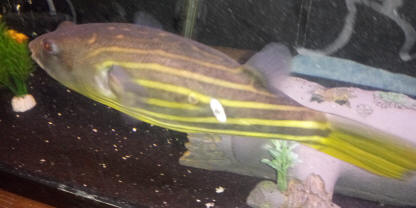 |
|
Re: Fahaka Pufferfish 11/16/19
Okay thank you so much. I will take everything out of his tank and also do a
water change. I bought him a 180 gallon aquarium 2 weeks ago and he was in
it for 3 days and it started leaking at the seal so I had to put him into a
40 gallon I had and 3 days later I moved him back into his 75 gallon
aquarium so he has been thru alot lately.
<Does sound as if he's perhaps gotten scratched at some point, and what's
happened is the wound has become slightly infected. A suitable course of
antibiotics or antibacterials should clear that up, and if the lesion
remains white rather than sore, red or bloody-looking, chances are good that
his own immune system has everything under control. Such wounds on Puffers
are not uncommon, and they are hearty fish that heal well given a balanced
diet and good water quality. Keep nitrate as low as possible (as
well as 0 ammonia and nitrite, of course) and focus on safe, thiaminase-free
foods such as cockles, squid, earthworms, and white fish fillet. Don't use
anything with thiaminase (like mussels and shrimps/prawns) because he needs
his immune system in tip-top shape, and certainly don't use anything likely
to carry bacteria (Tubifex, feeder fish, live shrimp, etc.).>
I appreciate you taking the time to respond, hope he will heal up and I will
do some research to see if there are any antibiotics or anything I could get
to help. Thank you so much
<Most welcome.>
|
|
Sick Fahaka puffer (RMF, any other thoughts?)<<Other than sadness,
no>> 4/14/19
Hi guys,
<Hello Nikola,>
My Fahaka puffer is sick. He is 4 years old. Attached few images of disease. It
all started like aquarium ich and it killed 6 loaches (fast breathing for a few
days then died). They looked like skin is peeling off
and excess mucus. Fahaka puffer got something else. It is looking like a bit
rough skin then just turns into white patch. He is not eating and fins are
clamped. What I saw is that excess mucus is made on him and today he was near
surface but not gasping for air just standing there (doesn't look he is
struggling to be there). After 2h he is down laying as before.
I have treated my tank with sera Omnipur and higher temperature (if it is ich on
other fishes)
<I do agree that treating as per Finrot, Velvet, and especially
Ichthyobodo/Costia would be a good approach here. This certainly looks like some
sort of bacterial infection, but the initial cause may well have been a
protozoan parasite of some sort. Costia is particularly sneaky, and causes what
is sometimes called Slime Disease. It's hard to treat, but I have found eSHa
EXIT alongside eSHa 2000 works well on pufferfish.>
and now started treatment with API general cure (metro and Prazi) because I
think it may be flukes.
<I'm not sure about that.>
Water is ammo 0, nitrite 0 and nitrate < 10. Tank has continual water
replacement (slow drip system) with a lot of bio filtration. I suspect on a new
fish being added 2 weeks ago.
Any help is really appreciated. We don't have veterinarian for fish in Serbia
and this fish is really dear to me. If you need more info just push one email
and I will answer asap.
<I would treat as per Ichthyobodoosis/Costiasis; this disease is common, can
kill fish quickly, and sometimes requires several courses of medication to
completely eliminate. Costia comes in several strains. If you're lucky, you have
a freshwater strain easily managed by exposing salt-tolerant fish
(such as freshwater puffers) to brackish water for extended periods.
Maintenance at a specific gravity of SG 1.005 will not stress freshwater puffers
at all, but if done for a few weeks, should eliminate freshwater Ostia. The
salt-tolerant (sometimes called "Asian strain") is more
difficult to shift, and almost certainly requires medications as described
above.>
All best,
Nikola
<Hope this helps, Neale.>
Re: Sick Fahaka puffer (RMF, any other thoughts?)
4/14/19
Thanks a lot for your reply. I will try to see what can be done further more.
<Glad to help. Cheers, Neale.>
|
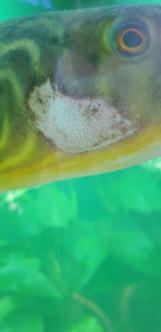 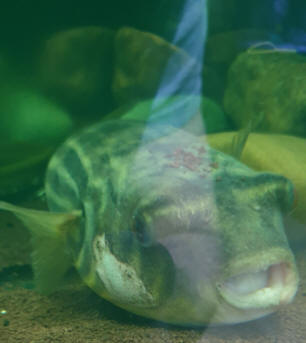 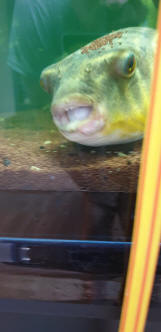 |
|
Re: Sick Fahaka puffer 4/18/19
Just to pass more info. I manage to help him. Flukes were responsible for the
sickness.
<Thanks for the update. Glad he's recovering! Neale.>
|
Fahaka teeth problem 11/27/18
Hi Neale!
How are you?
<Hello Nathaniel. All good here.>
Great news - my Fahaka is getting big - like 8 inches!!.
<They do grow fast.>
I've had him for a number of months now and he's been happily feeding on frozen
cockles (NOT in the shells). He usually eats 10-15 a day with 1 day off a week.
(plenty of heavy filtration and a decent sized tank - so no worries there!)
<Cool.>
The only problem is, I can see his teeth getting bigger. At the moment he has no
problems eating but I can imagine in the future it will be a problem.
<Indeed. Without lots of crunchy food, this is probably inevitable.>
I have only fed soft foods as he wasn't big enough for shell-on foods at first
and showed on interest in small snails.
<Snails will be eaten if the puffer is hungry enough. Besides molluscs, do also
try unshelled shrimp and crayfish, or even the legs from cooked crabs and
lobsters.>
I have now tried to introduce him to shell-on foods and he looks at me as if to
say "what do you expect me to do with that? Give me some proper food!"
<"Hunger makes the best sauce.">
I have tried, mussels, clams and snails and not one of them was touched. I have
even tried smashing them before putting into the tank to help him out but still
no interest.
<One possibility is to smear foods into something like a pumice stone or
artificial lava rock, such the puffer will have to work at the rock to extract
the food.>
I have ordered some half-shell clams and plan to starve him for maybe 2 days and
try those.
<Should help, but if partially shelled, the puffer may simply suck the meat off
the shell.>
Do you have any other suggestions?
Thanks
<Hope the above helps. Otherwise dentistry may be in your future. It's not
difficult, but easier avoided. Cheers, Neale.
Fahaka teeth problem 11/27/18
<Nate; I'd like to add this article on WWM for your perusal/review:
http://www.wetwebmedia.com/ca/volume_2/cav2i1/puffer_dentistry/puffer2.htm
BobF>
Re: Fahaka teeth problem 11/29/18
Thanks Neale!!
<Most welcome.>
|
Sick Fahaka Puffer Question 12/3/13
Hey Crew,
Long time reader, first time writer. I have a sick puffer that
neither myself nor my aquarium savvy circle of friends can figure out.
The setup is a single Fahaka puffer that I've had for just over a year
(was under 1 inch when I first got him/her, so tiny!) living in a 55
gallon freshwater, lightly planted tank with a sand bottom that I
perform roughly a 30% water change a week. Nitrite is at 0,
Nitrate is <20ppm, and Ammonia at 0 as well. Diet is currently
chopped squid, prawn, mussels, and clams (and the occasional peas when I
can sneak them in) soaked in VitaChem. The problem started a week
ago when I noticed a loss of pigment at the base of the caudal fin on
one side, but it looked kind of like a small scrape. No redness or
inflammation, just white tissue with seemingly no break in the skin
(like just the pigment peeled off). Two days later a small red
stripe along the bottom of the caudal fin developed and the puffer
stopped eating.
I ramped up water changes, doing 5 gallons a day, and the red stripe
disappeared, but the white area remained and grew to both sides of the
base of the caudal fin. Over the weekend, the white spot turned
more into only what I can describe as 'flesh eating bacteria.' It
now looks like a break in tissue and getting worse (and turning red).
Also, the caudal fin is undamaged and seemingly fine as he is still
wagging it in the stream of water from the powerhead. Oddly, the
puffer is more active and swimming around this past weekend with it
looking horrible than all of last week (though still not eating).
Attached are two pictures, one from mid last week with the beginnings of
the white spot and the other from this morning.
It's getting worse and any advice you have for me would be much
appreciated. Nothing new has entered the tank other than frozen
food in months so I can't pin point any sort of source. I was
planning on doing a Methylene blue dip this evening and take things from
there. Any guidance or hunches would be greatly appreciated!
You have a great website and set of experts here!
All the best,
Nick
<Hello Nick. Thanks for the kind words about WetWebMedia. I think your
hunch about a bacterial infection being to blame is a good one, though a
skin infection (such as Costia) might have been a triggering factor.
Hard to say without doing appropriate examinations of skin and slime
material under the microscope. A treatment of antibiotics (such as the
classic Maracyn 1 and Maracyn 2 combination) would seem the best way
forward. Don't worry about the lack of appetite; as/when the fish gets
better, it's appetite will recover, and in the meantime this fish can go
several weeks without food and not come to any harm. Do also visit
ThePufferForum.com and post your pictures there. There are some very
knowledgeable people there.
Do also review environment, diet, and so on critically. I would
recommend more than 55 US gallons for this species, and while your water
quality sounds good, I'd plan on a bigger tank and presumably a bigger
filter too.
Cheers, Neale.>
|
.JPG)
.JPG) |
Fahaka puffer, hlth., env. likely
2/16/13
Hi, I am a caregiver for someone who has a Fahaka puffer. The puffer was
doing fine until over the weekend someone added water to his tank
without treating the water with prime. Ever since he hasn't wanted to
eat and started getting black blotches all over ever now and again. I
tested his water and the nitrate no. 3 was high so we did a 30%water
change and it lowered it to 80 then we did another water change the next
day and it lowered it to 40.
<Ahh, this needs to be kept below 20 ppm. There are a few ways to
accomplish. Read here:
http://www.wetwebmedia.com/FWSubWebIndex/fwnitrates.htm
and the linked files above>
He still doesn't want to eat, we've tried garlic guard
but still no results. What else can we do? Thank you Melissa
<Fix the environment... the NO3, and all should be well. Have you read
here:
http://www.wetwebmedia.com/FWSubWebIndex/FahakaPufferF.htm
Bob Fenner>
Sick Fahaka Puffer 1/28/13
Dear WWW,
<Hello Vinny,>
My Fahaka Pufferfish Clarice is very sick. I've been trying to help her
get well by trying various things but so far she is not showing any
signs of improvement. About 5 weeks ago she was fairly active and had a
ravenous appetite for snails and frozen prawns. She is about 6 inches
long and lived in a planted 40 gallon aquarium (soon to be relocated
into a 150 gallon).
<Ah, would do this promptly; almost certainly part of the problem.>
About five weeks ago I fed her about 8 feeder goldfish.
She massacred and consumed all of them in a single night.
<Why? Why? Just about the worst possible thing you can do to an
expensive, treasured fish. There is no reason to ever, EVER use a
store-bought feeder, and the only feeder you should ever use will be
offspring of fish you keep and breed at home. But for puffers, feeder
fish are not at all needed.>
The massacre was even after eating her daily prawn. I was away for about
a week and if I recall, about a week after I returned she started to
decline.
First she started to get really spooky and have these strange freak out
sessions where she would get startled and slam into the glass and try to
jump out of the aquarium even. She was still eating the frozen prawns,
but not as eagerly.
<Stop feeding for a while if fish seem diffident. See what happens after
a week. Also do lots of water changes to lower the nitrate level.>
Eventually she started to sleep on the bottom more often and over time
she stopped wanting to eat a whole prawn. Now she has no appetite at
all. She is very lazy and doesn't respond to my presence. I can easy
handle her and she barely even notices. About a week ago I tested my
water and discovered the nitrates were really high (160+ ppm). I did a
couple water changes and brought them down to around 40 ppm. At the
advice of the local pet store I also started treating Clarice's tank
with Metronidazole and PraziPro because we suspected a parasite
infection due to my possible poisoning of Clarice with feeder fish.
<Quite possible. Was this the pet store that sold the feeders? Nice
little racket they have going on, eh?>
It's been about 5 days and I decided to move Clarice into a smaller
hospital aquarium to focus the medication and water changes. I have
noticed some opaque / transparent stringy (2-3 inches long) stuff that
stays attached to her butt.
<Ah now, sounds very much like stringy mucous in the faeces, a possible
sign of intestinal parasites such as Hexamita. Treat using
Metronidazole, via food if at all possible (it's far, FAR less reliable
added to the water). Consult a vet if possible as well.>
It breaks off eventually, but I have seen it come back about three times
now. I'm wondering if this might be some type of worm parasite that is
dying due to the medicine.
<Not worms directly, but mucous in the faeces.>
She is not acting any better so far. She is very tired, weak, slow,
seems to be breathing heavy and doesn't seem very alert. She does perk
up from time to time and swim around a little more deliberately for a
while. At this point I am going to continue doing daily 50% water
changes and continue with the medication. I'm swaying towards PraziPro
being the most relevant one to use, but do you suggest me trying
anything else, or a different strategy?
Thanks for any advice,
Vinny
<Do visit ThePufferForum.com ; the folks there are a bit sharp at times,
but they mean well, and their knowledge of pufferfish healthcare is
considerable. Cheers, Neale.>
Fahaka Puffer Tank Mate 3/12/10
Hi Crew,
<Hello,>
I recently cycled my 120g tank and am planning on having one single
Fahaka Puffer as I know they are generally intolerable of other tank
mates,
<Not "generally". Think "never". These are fish
that bite their OWNERS, let alone other fish!>
but am curious as to if he can be housed with a Striped Raphael
Catfish.
<Nope.>
I have owned one of these catfish in the past and know that it is
nocturnal and is rarely seen during the day as it likes to hide out in
caves and other small places. I also know they have spines on their
sides that act as a defense mechanism.
<Snails and shrimps have spines and shells that act as defences, but
these mean nothing to a pufferfish. See that beak? That's for
snapping through anything that looks edible or annoying.>
They seem to be able to handle their own with other aggressive fish
like cichlids.
<Totally different situation. Cichlids aren't viewing the
catfish as anything more than a threat to their eggs, and their
offensive capabilities are limited because of their small, relatively
weak mouths. At best, a cichlid will push a catfish out of the way
until the catfish is outside the territory of the cichlid. A pufferfish
is a totally different proposition,
since it's armed with a beak that evolved to crunch through shells
and skeletons.>
It seems like these two fish would not really cross each others path
and I just wanted a second opinion before I do something I might
regret.
Thanks.
<Pufferfish are essentially fish kept on their own, in their own
tanks.
Accept that fact and you'll do fine. Very few pufferfish species
are consistently safe with other types of fish, and certainly not
Tetraodon lineatus. Cheers, Neale.>
Fahaka Puffer Fretting 3/19/07
Hey guys, <Hey yourself, Pufferpunk here. Didn't they
teach you to use capital letters at the beginnings of sentences in
school (also when using I as a pronoun)? Never mind the
punctuation... Kidding aside, we have to correct all that,
before these letters are posted in our FAQs. That sure is a
big time waster for me. Next time, please review your letter
before sending.> <<Nuff' said? Yeah. RMF>> I have
recently moved my Fahaka puffer from a 55 gallon with a 7 inch
Ceylon and a 3 inch GSP, into a 36 gallon bow front by
himself. <Hmmm... you may find those two puffers left in
the 55g to become quite crowded, when the GSP catches up with the
Ceylon. They should be in practically saltwater by now,
too. General minimum recommendations for those species is
30g (GSP) & 40g (Ceylon).> The thing is, he used to be very
active in the slightly brackish 55 gallon tank and now that I moved him
into the 36 gallon he stays in the same spot all day. I see
him move around sometimes but its only once a day maybe and I have him
in just about complete freshwater now. <When I moved my
Fahaka from his 55g into his 125g tank, I thought he'd be happy but
he moped around & wouldn't eat for 3
weeks! It's just how they are--moody
beasts. He probably doesn't like the smaller tank,
either.> As an experienced aquarist I first checked water conditions
and everything is perfect and where it should be. No nitrates,
nitrites or anything. <That's odd... an established, cycled tank
should have some nitrates. How was the tank cycled?>
I'm wondering if there's anything wrong with him or is it just
that he's not moving as much because he's by himself and
there's no one for him to antagonize anymore? <Good thing you
moved him. I'm afraid as he matured, he probably would
have killed the other two. How big is he now? You
do realize they grow to 18" & require a 120g minimum
tank? They grow quite quickly too. Mine grew into
his 125g within 2 years, at 10" from a tiny 1" puffer. Your
help would be greatly appreciated, losing this puffer is not an option
for me as I will do anything possible to keep him going. <Start
saving for a much larger tank for this giant, along with a ton of
filtration for the bio-load he's going to produce. Look
at www.thepufferforum.com, for more discussion on
puffers. ~PP>
Re: Fahaka Puffer Fretting. Cycling a FW Puffer
Tank & BW Puffers 3/20/07 Ok, so there are some
nitrates in his tank but not enough to be afraid of. I also know about
the size issue as I already own a 16 inch Fahaka that's
currently kept in a 200 gallon. So the tank issue is not
a problem as I currently am waiting to move and put him into
a 150 all by himself as his current tank will soon turn into a ghost
shrimp tank, (I. E) puffer food. <Great!> I
didn't know that the Ceylon and GSP should be in saltwater by now
though. <See: http://www.wetwebmedia.com/BrackishSubWebIndex/gspsart.htm
> The issue concerning how I cycled the tank was that I put water
from the 55 tank and put it into the 36 and let it cycle for
about a week doing two water changes in between to get the salt content
lower. <There is nothing in using water from an established tank
that can cycle a new tank. I don't see how his tank
could possible be cycled in that way. See: http://www.thepufferforum.com/forum/library/water-filtration/fishless-cycling/
> If its his mood that's the problem that's not unexpected
at all, as he had been sharing a tank with a 5 inch yellow peacock
cichlid since day one and three months later I cant even find a scale
from the darn thing. So my main concerns now after you telling me this
is, what do I do with the freshwater fish that are in the Ceylon and
GSP's tank <Either set up a separate FW tank or find another
home for them. That tank is going to be too small for the 2
(adult) puffers, never mind more tank mates.> and how long should I
wait to seriously act on his disgruntled mood and further investigate
the situation. <1st thing I'd do is add Bio-Spira to the tank to
cycle it instantly. Keep an eye on water
parameters. You didn't mention how large the puffer is,
so I can't tell if tank size is the issue. Is he
eating? ~PP>
Re: Fretting Fahaka 3/20/07
3/21/07 Ok, so if the tank is not cycled, what do I do
with the fish in the mean time? <I'm assuming
you're speaking of the Fahaka tank? Test the water
daily, for ammonia, nitrites & nitrates & do huge daily water
changes, if necessary, to keep them as low as possible (ammonia &
nitrites should be 0 at all times).> To answer the question of him
eating, he is eating and every ghost shrimp I put in there disappears
within the day. <Ghost shrimp are basically non-nutritious, unless
gut-loaded with food.> Also where do I get this Bio-Spira stuff,
because I called three local fish stores and none of them have it and
can this stuff be put in with the fish in it? <Yes, you
should do a large water change & add it to your filter. If you
cannot find it locally, do a search, there are many online stores
selling it.> I am somewhat perplexed on what to do, as I'm
already starting to acclimate the other tank to a higher salt content.
<I'd wait until your FW fish are out of there, before raising
the SG. Also, don't raise it more than .002/weekly water
change or you will crash your system.> I have a divider that I could
use but I don't want to short the other puffers of their well
deserved space. <I doubt there'd be any way, short of Siliconing
a piece of glass across the middle of the tank, that would prevent salt
from mixing into the other side.> On the matter of size, I would say
that he is about 3 inches. <Won't last in that 36g tank for long
then, growing about 1/2" per month.> Also I'm not sure if
the puffer that I think is a GSP, is actually a GSP, because his
blotches are much larger than regular green spotted's and I
thinking that it might be an ocellated puffer. <Takifugu
ocellatus are a metallic green with bright round orange spots on
it's back. They are much more torpedo-shaped & have
a longer snout than a GSP. They really don't resemble
GSPs at all. Look here for ID: http://www.thepufferforum.com/forum/ug.php/v/PufferPedia/?sid=25b4c1cb72b4f21631afc47bbbf1d7f4
> Another issue concerning that tank is ever since I moved the
Fahaka, the so-called GSP, shall we say, has also began to bottom dwell
with no fin movement and only perks up and goes belly white during the
night or whenever I add salt to the tank. Never
in my four years of keeping puffers have I ever experienced
odd situations like these and am very concerned, as every
puffer owner is, when their little buddy goes ill or gets
pissed. <Check the water parameters in that tank
too. See: www.thepufferforum.com, for more
info. ~PP> Thank you so much for your help!
Food amount food for baby Nile puffer?
2/19/07
Hi,
We just got a baby Nile puffer
<Tetraodon lineatus... aka the Fajaka, Fahaka...>
yesterday who has settled down in his large tank and took food of
bloodworms very happily today. About 3" at present. We know
about all the types of food to give him, but cannot find out about
the amount each time for his size.
<Hard to gauge other than to say, no more than offering once a day
really... till the animal seems "full"... not bulging>
we have put a 3 little snails in so he can have something to
crunch for his teeth but has so far ignored them. Think he is
too small for cockles yet?
<You could try these... one at a time, pried open... removing in an
hour or so if not consumed...>
Any help would be greatly received as do not want to either over
or under feed in this important growth stage.
Many Thanks Denise & Paul
<And a long read here?:
http://www.google.com/search?q=Nile+puffer&rls=com.microsoft:en-us:
IE-Address&i.e.=UTF-8&oe=UTF-8&sourceid=ie7&rlz=1I7PCTA
Bob Fenner>
Nile/Fahaka Puffer, Tetraodon
lineatus 11/14/06
<Hi Jo, Pufferpunk
here. I have corrected all your improperly capitalized
words, so we can present this email to our FAQs. Next time
it will be sent back for you to correct!>
I bought a Nile puffer 3 days ago and was really badly informed by the
shop. I wish I had looked on the internet first!
<Did they tell you it will grow as large as 18" & require a
minimum of a 120g tank within 2 years? They grow
fast!>
They told me it would be fine to fill up the new tank with water from
my other tank with various tropical fish and put the puffer in the tank
the same evening. I now know the filter wouldn't have matured and
now my puffer has a cloudy looking eye and isn't moving much.
I've tested the water and the NO3 is on 0 and the NO2 the others
seem fine too. I'm not too great on the technical side so if you
could explain in a way I would understand I would be very grateful.
<For cloudy eye (due to poor water quality--fish don't get sick
in healthy water), add Melafix. The bacteria you need to
cycle a tank does not live in the water. It lives on the
surfaces of the tank. Mostly in the filter
material but also on gravel, glass, decor, etc. You can
squeeze the "dirt" from your older filters into your new
filter to help the cycle along. You should be doing 50-80%
daily water changes, until your tank is cycled. After the
tank is cycled, do 50% weekly water changes. My best
suggestion would be to add BIO-SPIRA to your filter, to "instant
cycle" your tank. I highly recommend
this. It really is not a good idea to cycle a tank with a
puffer at all! They have no protective scales or gill
covers. Very sensitive to ammonia/nitrites. How
large is the puffer & what size tank is it in?
For more info on your fish, go to:
www.thepufferforum.com ~PP>
Thank you, Jo
|
|

